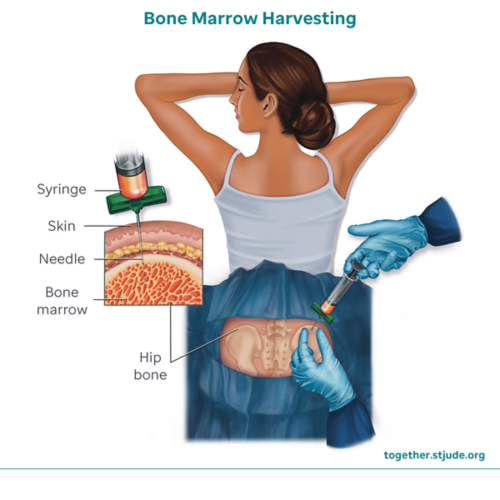What is a bone marrow harvest?
A bone marrow harvest is a procedure used to collect stem cells from the bone marrow. Stem cells (also called progenitor cells or hematopoietic stem cells) are cells that can develop into other types of cells, such as blood cells.
Stem cells for transplant can come from bone marrow or from the blood. Bone marrow is the soft, spongy tissue inside most bones. Bone marrow that is used for a transplant usually comes from the hip bone.
- An autologous transplant uses the patient’s own stem cells.
- An allogeneic transplant uses stem cells collected from another person (donor).
How to prepare for a bone marrow harvest
Before the procedure, the medical staff will explain what to expect and answer any questions. In most cases, the donor will be asked to:
- Sign a consent form.
- Have lab work and a physical exam before the bone marrow harvest.
- Take a bath the night before the procedure using a disinfectant cleanser provided by the care team. Once the skin is dry, use disinfectant wipes to clean the bone marrow harvest collection area.
- Follow fasting guidelines or instructions on when to stop having food or drink before anesthesia.
What to expect during the bone marrow harvest
Bone marrow harvest is usually performed in an operating room under general anesthesia, which causes a complete loss of consciousness like a deep sleep. The medical staff may use other forms of anesthesia to control pain.
Bone marrow is removed using a thin, hollow needle. This is similar to a bone marrow aspiration. A care provider will insert the collection needle through the skin into the back of the hip bone and into the bone marrow. Sometimes the care provider may need to use the front of the hip bone also.
In most cases, 2–4 sites are used. The needle is inserted several times until enough marrow is collected. Harvesting the marrow usually takes about an hour.
After collection, the harvested bone marrow is processed in a laboratory. The stem cells from the bone marrow may be given to the patient the same day or saved for use later. Harvested cells from the bone marrow can be combined with a preservative and frozen until needed.
What to expect after a bone marrow harvest
After the procedure, the donor will be moved to a recovery area to recover from anesthesia.
Staff will place a large dressing on the lower back called a pressure dressing. The dressing helps to reduce swelling, bleeding, and bruising. Under this dressing, thin adhesive bandages (Steri-Strips™) will be placed over each harvest site.
The donor may be able to leave the hospital on the same day of the harvest procedure. Medical staff will give instructions on how to care for the harvest sites.
The day after the procedure, the donor will return to the clinic for lab tests and an assessment. A nurse will remove the dressing, check the harvest sites for any signs of infection, and give instructions for care of the sites.
Possible side effects of bone marrow harvest
Bone marrow harvest can cause short-term side effects. Side effects may include:
- Pain, achiness, soreness, or stiffness around the harvest sites
- Bruising or swelling
- Tiredness or fatigue
- Nausea, vomiting, or dizziness from the anesthesia
Most side effects are mild and go away in a few days. More serious problems are rare, but they can occur.
Care of the harvest sites at home
A care provider will teach you how to take care of the wounds from the bone marrow harvest. Always follow the specific instructions given by your care team.
- Clean the harvest sites as instructed.
- Clean each site 2 times a day for 7 days using the betadine swabs provided. Betadine is an antiseptic that helps kill germs and prevent infections.
- Use a full pack (3 swabs) on each site.
- Clean the site in a circular motion. Start at the center and work outward.
- Allow the betadine to dry. Do not wipe off after cleaning.
- You may shower. But do not take any tub baths, go swimming, or soak in water for at least 1 week after the procedure.
- Take pain medicines as recommended.
- The Steri-Strips™ will eventually fall off on their own. This usually takes 1 to 2 weeks.
When to contact your care team
Watch for signs of infection or other problems. Use a digital thermometer to monitor body temperature. Call your clinic or return to the hospital if there is:
- A fever or body temperature 100.4°F (38.0°C) or greater
- Drainage from the sites where the needle was inserted
- Increased pain that does not get better with the recommended pain medicine
- Nausea or vomiting
- Any other change in condition




